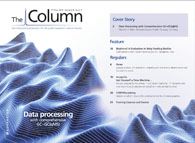Lacquered up
A team of Japanese scientists has developed a method for analysing the identity of a lacquer source using lithium ion (Li+) attachment mass spectrometry (Li+IAMS).
A team of Japanese scientists has developed a method for analysing the identity of a lacquer source using lithium ion (Li+) attachment mass spectrometry (Li+IAMS).1
Japanese lacquer is known to be one of the best ancient coating techniques in the world, and by identifying the lacquer source the results can help to determine its origin.
The team investigated the pyrolysis of Japanese lacquer films through temperature-programmed heating using direct probe-Li+IAMS. Among the pyrolysis products detected, carboxylic acids, phenols, catechols and aliphatic and aromatic hydrocarbons were the most common.
The team compared their results with those of a previous pyrolysis/gas chromatography/mass spectrometry study of Japanese lacquer samples. The comparison demonstrated significant differences between the two techniques in terms of the products and their distributions in the Japanese lacquer films. They concluded that their approach offered the opportunity to directly study the pyrolysis processes occurring in complex natural materials. It also suggested a way to determine the identity of a lacquer source by identifying different types of lacquer monomer.
1. Toshihiro Fujii et al., Journal of Analytical and Applied Pyrolysis, (in press) 2012.
This story originally appeared in The Column. Click here to view that issue.
A Novel LC–QTOF-MS DIA Method for Pesticide Quantification and Screening in Agricultural Waters
May 8th 2025Scientists from the University of Santiago de Compostela developed a liquid chromatography quadrupole time-of-flight mass spectrometry (LC–QTOF-MS) operated in data-independent acquisition (DIA) mode for pesticide quantification in agriculturally impacted waters.
Investigating 3D-Printable Stationary Phases in Liquid Chromatography
May 7th 20253D printing technology has potential in chromatography, but a major challenge is developing materials with both high porosity and robust mechanical properties. Recently, scientists compared the separation performances of eight different 3D printable stationary phases.

.png&w=3840&q=75)

.png&w=3840&q=75)



.png&w=3840&q=75)



.png&w=3840&q=75)









